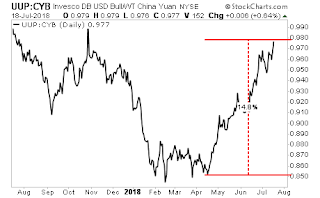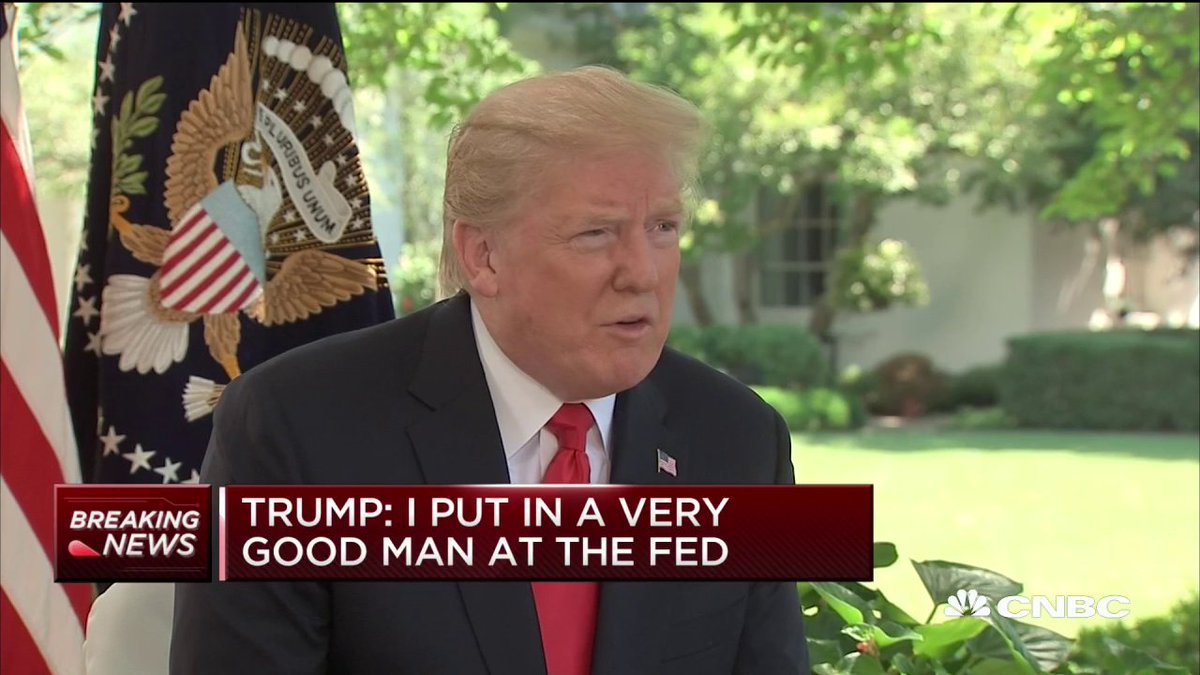
This is an issue I have touched on multiple times since the beginning of this year, and it is something I predicted long before Trump's election in 2016. But it is obvious that the schizophrenic nature of stocks needs to be addressed in a very concise, no-holds-barred fashion, because there are still far too many people who are looking at all the wrong causes and correlations.
First, let's be clear: stock markets are NOT tracking the news headlines. The past month should have proved this if there was any previous doubt.
It is hard for investors and some analysts to grasp this fact, primarily because for at least the past few years it appeared as though stock markets were utterly dictated by headlines out of Bloomberg, Reuters and other mainstream media outlets. Once investors and analysts became used to this narrative it was difficult for them to adapt when the dynamic changed. They are still living in the past based on an assumption that was never quite correct to begin with.
In reality, headlines never actually dictated stock prices; it was always the Federal Reserve among other central banks.
As I and others have noted consistently, stock market valuations for the past several years have tracked almost perfectly with the Fed's balance sheet. That is to say, every time the Fed purchased more assets and increased the balance sheet, stocks went up.

After years of the notorious "Fed Put," we now have an entire generation of investors and market writers that have never experienced a stock environment in which equities actually fall according to the health of their corresponding companies or the economy at large. The past year has been a bit of a shock for them, and it's only going to get worse.
The Fed's large scale interventions in stocks are now essentially over, which is exactly why stocks are no longer hitting new historic highs every month as they used to. The massive bull market rally of the post credit crash world of 2008 has stalled, and here are the reasons why.
Central Banks Tapering QE
The Federal Reserve was only the first to begin tapering its purchases of treasury bonds. Japan is now in the midst of what many are referring to as a "stealth taper" of its own bond purchases. TheEuropean Central Bank has announced it will likely end its QE program by the end of this year. Bond purchases helped first to support the ever growing debt burden of the governments and nations in question, but along with artificially low interest rates, it made bond investment less desirable in terms of profits. This pushed the majority of investors into stocks, where profits were essentially guaranteed by the central banks.
Now that QE is ending around the world and rates are rising along with yields, bonds are becoming a competing asset, luring investors away from stocks once more.
Central Banks Raising Interest Rates
The Federal Reserve has been raising rates consistently since the end of 2016, exactly as I predicted they would before the U.S. election. Interest rates are a direct influencing factor in stocks — low interest rates and cheap overnight loans to corporations by the Fed allowed these companies to continually buy back their own stocks, thereby decreasing the number of stock offerings available on the market and artificially boosting the value of the stocks that were left circulating.
Corporation have taken on a historic level of debt not seen since 2007 in order to keep their stocks prices high. Now that interest rates are rising, the party is almost over. The only source of capital left to fuel the stock buyback bonanza has been the Trump corporate tax cut. Instead of using this cut as a means to increase employment, innovation and to bring manufacturing back to the U.S., companies have instead squandered it on boosting the stock market yet again. However, as we have seen this year so far, without the aid of cheap money from the central bank the effects of stock buybacks are diminishing.
How long will it take for corporations to completely exhaust this last revenue stream? I predict stock buybacks will die off by the end of this year. And with rising interest rates, all that debt they took on in order to keep stocks elevated will now become rather expensive to hold onto. Once stock buybacks diminish, markets will crash.
It's important to note that the Fed is not the only central bank that is raising interest rates. The Bank of Canada and the Bank of England among others are beginning to push higher rates as well.
Federal Reserve Cutting Balance Sheet (And Hiding The Effects)
The Fed has been the single most important trigger for stock markets. Period. As noted above, it was the Fed that created the historic bull market rally after the derivatives collapse. Jerome Powell, the current chairman of the Fed, stated back in 2012 that this was the case, and also made statements on what would happen if the Fed ever raised interest rates and cut asset purchases, ending the central bank's "short volatility position."
What did Powell predict in 2012? Essentially, a stock market crash. And, yet, as the new Fed chair he is implementing the exact measures he warned about back in 2012.
With every new balance sheet cut and rate hike, the Dow Jones in particular tends to lose 1,000 points or more. The damages have been mitigated by continued stock buybacks from corporations as well as smaller asset purchases by the Fed after the fact, but as already mentioned, the buyback stop gap will be ending shortly.
I should also note that the St. Louis Fed recently ended its reporting of data on cuts from week-to-week (known as FRED data). There are other sources for this data, but they mainly show how much was cut per month, not WHEN in the month those cuts were made. The St. Louis data was originally reported on a weekly basis, which means we can more closely compare Fed asset cuts to stock market movements.
If we look at a 2018 year-to-date chart of the performance of the Dow Jones side by side with the St. Louis FRED chart of balance sheet cuts before the Fed discontinued it, we can see for example that on January 24th the Fed made a dramatic cut in their balance sheet, and two days later on the 26th the Dow began to drop precipitously. On February 7th the Fed increased asset purchases slightly, and only two days later stocks began to recover. On February 21st the Fed cut dramatically once again, and once again stocks plunged. On March 2nd the Fed added a smaller level of assets and stocks recovered. I would also note that when the Fed does not cut, but simply keeps assets mostly static as in May, stock rise. Like clockwork, only when the Fed dumps its balance sheet do stock markets fall.

I believe the Fed is not attempting to hide the size of its asset dumps when it discontinued FRED data, but it is attempting to hide the exact TIMING of when the cuts occurred. In this way, they hope to distance themselves from any blame by making it more difficult to connect Fed cuts to specific weekly plunges in stock markets.
As a side note, the argument that market plunges and rallies are somehow due to algorithmic computers and not the Fed is misguided. FRED data was normally released long after stock movements had already begun. Meaning, any influence algorithms might have had came AFTER the fact, not before or during the Fed's balance sheet actions. Algos are not magic despite predominant and odd misconceptions; they DO NOT predict the timing of Fed asset cuts or purchases. They do nothing more than lag behind the already direct influence of the Fed on equities.
The Fed is also suddenly attempting to change the way it reports on Yield Curve data, which has in the past been a very accurate indicator of when a recession will take place. Why? Most likely because the Fed has been pushing the claim that the economy is in swift recovery when their own data shows that it is actually in swift decline. The Fed needs a rationale for their rate hikes and balance sheet cuts - actions which they KNOW will cause the next financial crash. The central bankers are hiding FRED data and Yield Curve data because they are deliberately sabotaging what remains of the US economy, and they are seeking to do this without taking any responsibility.
Trade War Distraction
The trade war continues as the most effective possible distraction from central bank activities. In every instance of a stock market decline, which takes place after every instance of a Federal Reserve cut in the balance sheet or an interest rate hike, Donald Trump also seems to make yet another trade war announcement. During Jerome Powell's most recent congressional hearing, discussion strayed far from any examination of the Fed's culpability for economic weakness. Instead, the majority of questions revolved around the "threats" presented by Trump's tariffs and their negative affects on markets.
The only outlier has been the "official launch" of the trade war with China, which saw stock markets suddenly rise. I have witnessed numerous analysts and commentators frantic over the fact that stocks did not fall on the headlines. Some have even suggested that the investment world "loves the trade war."
What these commentators do not understand is that the headlines are meaningless and the trade war has little to do with the behavior in equities. It is the Federal Reserve and to some extent other central banks that are controlling stock market prices, along with corporate stock buybacks which are facilitated by the Federal Reserve's low interest rates.
I've said it before and I'll say it again — what we are witnessing is a controlled demolition of the U.S. economy, and stock markets are merely an extension of this process. They are a lagging indicator, not a leading indicator. Stocks fall when the Fed dumps more assets, and these cuts are growing larger and larger as 2018 drags on. Stocks rise when the Fed slows asset cuts in a particular week, or when companies initiate more stock buybacks. That's it. That is all there is. There is nothing else to look at when predicting what stocks will do at any given time.
The facade will end when balance sheet cuts expand to a point at which buybacks cannot keep up and the slack in markets grows too fast. Or when stock buyback cash runs out (probably by the end of this year). The trade war can and will cause various problems within the global economy, but the greater cause of fiscal distress will always be central banks. They are to blame for any future crisis.




































